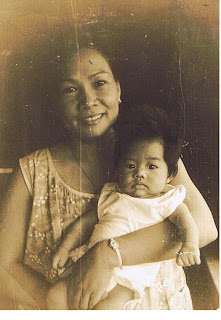Whenever I see achara I think about
our little piece of heaven in Tagaytay. Maybe it's because of the fresh
vegetables that I see at Mahogany market, or maybe the numerous plants surrounding
the house. My parents bought a small piece of land and erected a modest 2-storey
house right before my father retired from working in London for more than 30
years. Yes, my Tatay was an OFW even before the word was invented (that was in
1972).
 |
| the girls when they were younger |
Around the house we planted trees... Indian mango, atis, anonas, rambutan, buko, santol, duhat, chico, papaya, langka, guyabano (soursop), guava (the big ones), we even had an apple tree (it flowered, but never had any fruit). We also have sili, malunggay, kamias, kamoteng kahoy, tubo (sugarcane), luya, at one time my brother planted eggplants, okra, even pineapples. My Nanay also have flowering plants like roses and orchids.
How can you NOT love a place like that? The cool, fresh air,
the serenity of the place, the plants, the crowing of my brother's fighting
cocks early in the morning, the sound of birds greeting you upon waking up, and
the chirping of crickets at night lulling you to sleep... yep, it's heaven all
right!
 |
| Bea loves exploring around the property |
At first, we only stayed there during weekends because the
kids go to school and hubby works in Manila. We'd leave for Tagaytay every
Friday evening, then return to Manila a little after lunch on Sundays. All we
did there was sleep, eat, watch TV, sleep some more, and eat, eat and eat. Oh, I
forgot to add that I cook a lot when we are there, and the kids get to run
around and have fun outside.
We would go to Mahogany Market and buy beef for bulalo, vegetables for our lumpiang sariwa, tinapang tawilis, danggit, and tuyo, fruits in season (if there are no ripe ones in our yard), espasol, kalamay Indang, and other kutkutin like nilagang mani. We very seldom buy chickens because as I have said, my oldest brother owns a lot of fighting cocks and hens too, so when we want to make tinola, we just run after one of the hens foraging around. Occasionally, when one of his fighting cocks win in sabong and he gets to bring home the loser, but fighting cocks need to be stewed for a loooonnnnggg time before you'd be able to eat it, but the broth is oh so yummy!! Come to think of it, a fighting cock is called "tinali" in Filipino, when it loses in a cockfight it becomes "tinalo", and when it is brought home it becomes "tinola" hmmmm....
The tinapang tawilis, fried crisp and served with my nanay's homemade atchara (the papaya comes from the yard) is to die for. How can you go wrong with that? I think we always go back to Manila a few pounds heavier everytime LOL...
We would go to Mahogany Market and buy beef for bulalo, vegetables for our lumpiang sariwa, tinapang tawilis, danggit, and tuyo, fruits in season (if there are no ripe ones in our yard), espasol, kalamay Indang, and other kutkutin like nilagang mani. We very seldom buy chickens because as I have said, my oldest brother owns a lot of fighting cocks and hens too, so when we want to make tinola, we just run after one of the hens foraging around. Occasionally, when one of his fighting cocks win in sabong and he gets to bring home the loser, but fighting cocks need to be stewed for a loooonnnnggg time before you'd be able to eat it, but the broth is oh so yummy!! Come to think of it, a fighting cock is called "tinali" in Filipino, when it loses in a cockfight it becomes "tinalo", and when it is brought home it becomes "tinola" hmmmm....
 |
| Ate and I |
The tinapang tawilis, fried crisp and served with my nanay's homemade atchara (the papaya comes from the yard) is to die for. How can you go wrong with that? I think we always go back to Manila a few pounds heavier everytime LOL...
It is so much fun to pick fruits and vegetables in your own
backyard. Somehow, fruits and vegetables that you yourself have planted and
harvested seem to taste a lot better than the ones bought elsewhere. Isn't it
nice to hear someone say... "pumitas ka nga ng kamias para sa pinangat", or
"ikuha mo nga ako ng dahon ng saging at magsusuman ako", or "kuya, ipitas mo nga
ko ng dahon ng sili at ihukay mo ako ng luya para sa tinola."
We miss going to Tagaytay now that we're here in the US, even the kids talk about it often because there they're free to roam around, run, explore , play with their cousins, pretty much like how I spent my childhood days in Valenzuela City.
Maybe this is why I used love playing FarmVille and Country Story
on Facebook, it reminds me so much of that little piece of heaven that
we call our second home...in Tagaytay :)
Below is the video for Nanay's homemade achara, which we make all time time whenever we're in Tagaytay because we have lots of papaya trees there. I've been told that this tastes better than the store-bought ones, so I hope you'll like it too.
INGREDIENTS:
4 cups (or more) of grated raw papaya (squeeze out juice)
2 cups julienned carrots
2 cups julienned bell pepper
2 cups sliced shallots (sibuyas Tagalog)
1 1/2 cups sliced garlic
5 cups vinegar
12 teaspoons (4 tablespoons) salt
6 1/4 cups sugar
raisins



.jpg)
.jpg)







